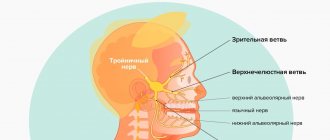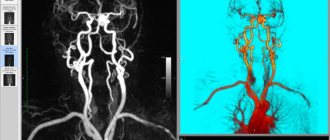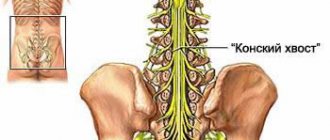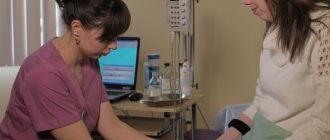September 24, 2019
29058
0
3.6 out of 5
Trigeminal neuralgia, or, as it is also called trigeminal neuralgia, is a disease of the peripheral nervous system that affects one or more branches of the trigeminal nerve that provides facial sensitivity. This is accompanied by sudden, severe paroxysmal pain, the localization of which depends on which branches are affected, since they are responsible for the innervation of different thirds of the face.
The doctors at SL Clinic will help you undergo a comprehensive examination, establish the cause of pain in the face or neck and find an effective way to eliminate it. We have doctors waiting for you who are not indifferent to the suffering of others, who are able to select the most effective conservative therapy or, if indicated, perform gentle surgical intervention. As a result, you will be able to leave the clinic, forgetting about the debilitating pain in your face.
Causes of trigeminal neuralgia
Neuralgia can be primary or secondary. The first develops in isolation, while the second is a consequence of the progression of a particular disease. It occurs in both women and men.
Today, all the reasons that provoke damage to the trigeminal nerve are still unknown. However, it is known for sure that this is facilitated by:
- pathologies of the nervous system, including cerebral palsy, multiple sclerosis, encephalopathy that develops after a head injury, epilepsy, brain tumors, viral and tuberculous meningoencephalitis, hypoxia, cerebrovascular accidents, etc.;
- viral diseases, in particular polio, herpes infection;
- odontogenic causes, including jaw injuries, gumboil, errors in tooth filling, non-standard reaction to anesthesia;
- compression of the trigeminal nerve, which can be caused by brain tumors, scars formed after injuries or operations, as well as significantly expanded blood vessels as a result of atherosclerosis, aneurysm or congenital disorders, stroke or increased intracranial pressure due to osteochondrosis.
- compression of the trigeminal nerve by the posterior cerebellar artery. As a result, the constant pulsation causes irritation of the nerve and its inflammation.
Increase the risk of developing the disease:
- frequent stress;
- chronic fatigue;
- metabolic disorders;
- vitamin deficiency;
- autoimmune pathologies or allergies;
- severe infectious diseases;
- inflammatory processes in the oral cavity.
Neuralgia is not accompanied by inflammation of the nerve. It occurs as a result of demyelination of the nerve fiber or the occurrence of disturbances in the regulation of its functioning in the central nervous system. In 80–90% of cases, demyelination occurs. The destruction of the specific myelin sheath, which acts as a kind of insulating layer of the nerve, occurs due to compression of the Gasserian node by pathologically altered vessels and neoplasms of various natures. Therefore, impulses coming from the central nervous system spread to nearby nerves, which provokes pain.
In the second case, nerve impulses are transmitted at a different speed. This causes irritation of the neuron nuclei and, as a result, pain.
Causes. Why did this happen to you?
Women over 40 are most unlucky with trigeminal neuralgia - this disease occurs most often in them. There are 3 groups of reasons:
When the source is inside the skull
Damage to the nerve nucleus in the brain, aneurysm and compression of the roots of the trigeminal nerve in the cranial cavity, vascular atherosclerosis, tumor, multiple sclerosis - destruction of the myelin sheath (“insulation”) of the nerve.
When Trigeminal Neuralgia Occurs Due to Infection
Most often it is the herpes virus. It is activated against the background of reduced immunity - during hypothermia, emotional stress, chronic fatigue.
When the reason is local
The disease often develops due to irritation of the trigeminal nerve due to sinusitis or caries, a complication after tooth extraction.
Symptoms of the disease
The trigeminal nerve is part of 12 pairs of cranial nerves, is the 5th pair and runs along both sides of the face. It is formed by three bundles:
- ophthalmic – responsible for the innervation of the forehead, temporal and superciliary regions, eyes and eyelids;
- maxillary - responsible for the transmission of nerve impulses in the area of the upper jaw, facial muscles and nose area;
- mandibular - innervates the neck, lower jaw and chin.
Accordingly, the clinical picture of neuralgia will depend on which branch of the trigeminal nerve is affected. This is accompanied by:
- sharp short-term burning, powerful one-sided pain strictly along the affected nerve bundle, lasting up to 3 minutes and repeating from 1 to 10 times during the day (at night, lumbago is observed in less than 1% of patients);
- pain always occurs in the same area, then flows to a neighboring area, but does not radiate to other parts of the body;
- spasms of facial muscles during an attack;
- intensive separation of saliva and tear fluid;
- dilated pupils;
- absolute immobility of a person throughout the entire attack;
- the occurrence of pain when touching the skin in the projection of the affected nerve branch, so patients always describe the localization of discomfort without directly touching the face.
In 7% of patients, pain persists for several days. But in the initial stages, patients may only be bothered by short-term, mild shooting pains. Seizures usually occur spontaneously. But they can also be provoked by exposure to specific trigger points (most often located in the area of the nasolabial triangle).
If the reasons for the development of pathology lie in disorders affecting the brain, their manifestations may additionally be present: differences in the size of the pupils, difficulty breathing, drooping eyelids.
Thus, making a diagnosis is not difficult for an experienced doctor, since the symptoms of trigeminal neuralgia are quite specific. Frequent repetition of attacks while brushing teeth, talking or eating only confirms it.
Symptoms
The main symptom is very severe pain in the facial area - lower jaw, cheeks, gums, lips, forehead and eyes. The pain is very strong, reminiscent of an electric shock. Most often it is one-sided, but it can also be on both sides. The attack lasts from a few seconds to 1-2 minutes. There can be 1-2 attacks per day, or several dozen or even hundreds. The pain appears suddenly. Any little thing can trigger it - touching your face, chewing, talking, brushing your teeth. During an attack, the patient seems to freeze, trying not to move or speak. Over time, the number of attacks increases and the pain intensifies.
Diagnostic methods
In order to accurately determine the cause of neuralgia, the neurologist prescribes a number of instrumental examination methods to the patient:
- MRI is a safe research method that allows 100% accurate determination of pathologies of the brain, blood vessels, sclerosis, osteochondrosis;
- CT scan – makes it possible to diagnose diseases of the central nervous system;
- electroneurography or electroneuromyography - helps to determine the speed of impulse movement along the nerve fibers and determine the level of damage to the trigeminal nerve, as well as the mechanism of neuralgia (during electroneuromyography, the sensitivity threshold of muscle fibers is additionally determined, as well as the degree of their contraction).
Laboratory diagnostics are usually not performed, since in the absence of concomitant diseases, blood and urine values are normal.
Treatment of trigeminal neuralgia
Initially, treatment always begins with conservative therapy. Only if it is completely ineffective, patients are offered surgery.
Conservative treatment of trigeminal neuralgia includes:
- drug therapy;
- physiotherapy;
- massage.
The use of folk remedies is possible with the permission of a neurologist, but only as a supplement to taking medications and performing physiotherapeutic procedures. Traditional medicine alone is powerless to combat the disease.
It is important not to let the course of neuralgia take its course. Non-intervention can subsequently provoke serious damage to the nervous system, which will not only provoke prolonged pain, but also paralysis or paresis of the facial muscles, hearing loss, nervous tics and facial asymmetry.
Drug treatment
The basis of therapy is the prescription of carbamazepine drugs and its analogues of new generations. This compound is classified as an anticonvulsant or anticonvulsant. It was first synthesized in the middle of the last century. Subsequently, carbamazepine was improved, as a result of which oxcarbazepine, pregabalin and other anticonvulsants appeared on the pharmaceutical market, causing less side effects and giving a more pronounced effect.
Therapy begins with minimal doses of the selected drug. If there is no positive result, the neurologist gradually increases the dosage until the signs of neuralgia disappear. Treatment is continued for at least 30 days, after which a decision is made about the possibility of reducing the dose. If attacks recur, a re-consultation with a doctor and a new review of the dosage is required.
In approximately half of the cases, it is possible to completely eliminate the pain syndrome and gradually stop taking anticonvulsants. However, their effectiveness progressively decreases as the duration of neuralgia increases. Therefore, patients living with this diagnosis for several years require longer-term use of carbamazepine and its analogues.
Unfortunately, in severe cases, the symptoms of neuralgia sometimes cannot be eliminated even within 10 years. There is also a certain percentage of people who are immune to the drugs used.
Additionally, patients are prescribed:
- muscle relaxants to reduce muscle tone;
- agents that improve blood circulation to normalize nerve nutrition and restore the myelin sheath;
- drugs from the NSAID group that have anti-inflammatory and analgesic effects;
- antidepressants to reduce the speed of pain impulses;
- B vitamins.
Physiotherapeutic treatment
Physiotherapy helps increase the effectiveness of drug treatment and helps reduce the dosage of medications used. For these purposes, courses are prescribed:
- UVR - the use of mid-wave ultraviolet irradiation leads to the active release of neurotransmitters responsible for inhibiting excitation. Traditionally, the course includes 10 procedures.
- Laser therapy – thermal laser energy can reduce the sensitivity of nerve fibers. Usually 10 sessions of 4 minutes are prescribed.
- Diadynamic currents - the method involves fixing electrodes in the area of the most sensitive points, including the nasal mucosa, if required. An electric current with a frequency of 50,000 Hz, called Bernard current, is passed through them. This helps lower the pain threshold and block the transmission of nerve impulses along the trigeminal nerve. Thanks to this, complete pain relief can be achieved. The addition of electrophoresis increases the effectiveness of the procedure. As a rule, to obtain a good effect, several courses lasting 5 days are required. Between them there are breaks for a week. Each session takes about a minute.
- UHF - high frequency currents have proven themselves in the treatment of neuralgia. Their impact leads to improved blood circulation and lymph flow, as well as restoration of the sodium-potassium nerve membranes transmitting impulses. Patients are recommended to undergo 15 to 20 sessions, each lasting 15 minutes.
- Electrophoresis is a method often used to eliminate pain by injecting painkillers directly into the lesion. For neuralgia, novocaine, platyphylline and diphenhydramine are administered using electrophoresis. They block the transmission of nerve impulses by acting on potassium-sodium channels. To improve the nutrition of nerve fibers, which is especially important when the myelin sheath is destroyed, B vitamins can also be administered. Electrophoresis is carried out 10 times every 2 days.
Acupuncture also gives good results. A targeted effect on the nerve receptors of trigger zones and on similar points on the opposite side of the face helps eliminate pain. The duration of treatment for each patient is selected individually. In some cases, it is necessary to install needles for a fairly long period of time - more than a day. But often several procedures are enough to obtain pronounced results.
Massage
Manual influence on the muscles of the face, neck and head as a whole during remission of the disease helps to activate lymph and blood flow. Therefore, massage is indicated for patients with trigeminal neuralgia. A correctly performed procedure helps prolong the remission of the disease, but requires highly qualified chiropractor.
The procedure is carried out very carefully. When performing it, the techniques of rubbing, stroking and vibration are used, but the impact on trigger zones is completely excluded. A massage session performed by an insufficiently qualified specialist can provoke an attack of pain.
Surgical treatment of trigeminal neuralgia - surgery
When the possibilities of conservative therapy have been exhausted, and the patient continues to suffer from attacks of severe pain, surgical treatment of trigeminal neuralgia is recommended. This still occurs in about 30% of patients. Therefore, for them, surgery is the only way a person can get rid of severe pain.
There are several methods of surgical treatment of neuralgia. All of them are aimed at eliminating the irritating effect on the nerve, provided that its source is known, or destroying the nerve.
The methods differ not only in the degree of effectiveness and safety, but also in price. For each patient, the surgeon individually selects the most appropriate method of performing the operation, based on the level and degree of damage to the trigeminal nerve, the clinical picture and existing concomitant diseases.
Today in the arsenal of neurosurgeons there are:
- microvascular or microvascular decompression;
- radiofrequency ablation;
- rhizotomy with glycerol;
- microcompression with a balloon;
- stereotactic radiosurgery.
In the absence of age-related and somatic contraindications, when diagnosing a neurovascular conflict, preference is usually given to microvascular decompression, since it is one of the reconstructive operations and does not lead to loss of sensitivity in one or another area of the face. But when concomitant diseases are detected in a patient, minimally invasive techniques are usually chosen, in particular radiofrequency ablation. It is also indicated for most elderly patients.
But when preparing for surgery, patients should understand that surgical intervention on the nerves requires the highest possible qualifications from a neurosurgeon. The slightest careless movement in such situations can lead to irreversible consequences, including complete loss of facial sensitivity. Therefore, it is important to approach the choice of a clinic and specialist extremely responsibly.
By contacting the SL Clinic, you minimize the risks of the operation, since we employ some of the best neurosurgeons who have considerable practical experience and are scrupulous about the problem of each patient. The clinic has modern equipment, which further increases the chances of success of the operation and reduces the likelihood of postoperative complications. Don’t waste time searching for a suitable medical center, entrust your health to the professionals at SL Clinic and you are guaranteed to receive top-level medical services. The cost of treatment for each method is given in the clinic’s price list.
Microvascular decompression
The Jannette procedure, or microvascular decompression, is often used for facial neuralgia. Its main advantage is the preservation of the nerve, while all other operations are destructive. Therefore, after microvascular decompression there is no risk of numbness of part of the face.
But it can only be used in situations where the trigeminal nerve is compressed by a nearby passing blood vessel, from which pulsation is transmitted to the nerve fiber, which provokes pain.
Microvascular decompression is performed openly through an incision behind the ear. The surgeon enters the cranial cavity after trephination of the posterior cranial fossa and revises the position of the trigeminal nerve root, the superior and inferior anterior cerebellar arteries, as well as the superior petrosal vein. After identifying the compression site, he separates the pathologically dilated vessels and introduces a special Teflon separating gasket. It will protect the nerve from mechanical irritation by the pulsating vessel, which will ensure pain relief.
In the vast majority of cases, the method leads to final recovery. Relapses are extremely rare. But microvascular decompression is an open surgical procedure and is associated with high morbidity and intraoperative risks. Therefore, performing the operation requires highly qualified surgeons.
After microvascular destruction, patients must remain in the hospital for up to 10 days. During this time and afterwards, they may experience pain caused by post-operative muscle spasms. To relieve them, taking antispasmodics or NSAIDs is usually sufficient. As the body recovers, the intensity of the pain decreases and soon disappears completely.
Rehabilitation involves taking a number of medications, undergoing a course of physiotherapeutic treatment, and subsequently massage sessions. Such a set of measures will contribute to a speedy recovery and consolidation of the results achieved through surgery.
Radiofrequency ablation
The method is one of the percutaneous operations and is considered the most effective and safe in the treatment of a large number of different diseases, including trigeminal neuralgia.
With the help of an image intensifier, the surgeon is able to precisely control his every movement and the time of exposure to radio waves. Other advantages of the method include:
- no risks associated with general anesthesia;
- extremely short and easy rehabilitation;
- possibility of early activation of patients.
Radiofrequency ablation does not require large incisions and significant tissue trauma. The destruction of the pain-provoking branch, its peripheral node or root is carried out through thermal energy released when ultra-high frequency currents pass through biological tissues.
It is carried out using special equipment consisting of a generator and two electrodes: damaging and indifferent. Ablation of the nerve fiber is performed around the bare end of the damaging electrode. It is introduced into the patient’s body to the selected point of destruction using a hollow guide needle. The length of such a cannula is 100 mm. It is installed under the control of the image intensifier to avoid accidental injury to healthy nerves.
A current with a frequency of 100 Hz is used to destroy sensory fibers, and 2 Hz for motor fibers. Radiofrequency ablation is performed under local anesthesia, so the patient remains conscious throughout the operation. He may feel a slight tingling sensation as the needle gets closer to the affected nerve. To accurately determine the desired branch of the nerve, it is stimulated with current.
After identifying the damaged branch, the electrode heating mode is turned on. It can heat up to 70°C, then the exposure time is only one and a half minutes. But it is preferable to use the pulsed ablation mode, which involves heating the tip of the active electrode only to 42°C. This completely eliminates the possibility of burns to surrounding tissues, but complete ablation requires 2 minutes.
In general, the entire procedure takes no more than 40 minutes. In 90% of cases, it leads to complete recovery, and the pain syndrome either disappears immediately after its completion, or a gradual increase in effect is observed over 6–8 weeks.
After radiofrequency ablation, the patient does not require complex rehabilitation or long-term bed rest. He can leave the clinic the same day.
Percutaneous selective rhizotomy with alcohol
The method involves performing an injection of the drug under MRI or CT control. A thin needle is inserted into the area of the affected nerve root, after which the solution is injected in small portions. The destruction of part of the nerve fiber occurs 3–4 hours after the injection, as a result of which the possibility of conducting a pain impulse is eliminated.
The technique is very old and was used before when there were no other more modern methods of treating neuralgia. This does not exclude the possibility of a relapse, but is not associated with a high risk of loss of sensitivity in the area of innervation of the affected branch of the trigeminal nerve.
Microcompression with a balloon
The operation involves the insertion of a special needle equipped with a small empty balloon. It is brought directly to the affected trigeminal nerve root and inflated until a persistent compression effect is obtained. Pressure has a destructive effect on the nerve fiber and leads to the elimination of pain.
Stereotactic radiosurgery
For more than 50 years, the treatment of neuralgic disorders has been carried out using the so-called Gamma Knife or CyberKnife. This completely bloodless technique does not require any incisions. The effect is carried out through precisely directed ionizing radiation to the affected area of the trigeminal nerve. Guidance is carried out using anatomical landmarks and a computer.
The rays formed by several hundred sources penetrate tissue without damaging them and are precisely focused at the point of impact, creating the required concentration of radiation. The operation, including preparation, takes one day and the patient can leave the clinic immediately after it. When performed correctly, there is absolutely no risk of side effects and complications.
Gamma Knife affects the nerve root located at the point where the brainstem exits the brain. The operation leads to a lasting recovery in 80–90% of cases. Only 7% of patients experience a temporary decrease in facial sensitivity after it.
The method is used to help all patients in whom conservative therapy has failed or was accompanied by severe side effects. In addition, it can be used to treat patients who have previously undergone microvascular decompression and other surgical interventions without obtaining positive changes. But the cost of stereotactic radiosurgery is significantly higher than other methods of surgical treatment of the disease
How does pulpitis manifest?
You can tell if a nerve is affected by an acute toothache. By the nature of the change in pain symptoms, the doctor can judge the duration of the pathological reaction.
The fact is that at the very beginning of inflammation of the tooth nerve, attacks of severe pain rarely occur. A person is bothered by mild discomfort that periodically appears in the area of the affected unit.
A little later the pain becomes throbbing. It intensifies during meals and at night. Usually the patient cannot understand which tooth is bothering him. It only indicates the direction of localization of painful sensations.
Due to inflammation of the pulp, significant pressure is exerted on the nerve fibers. Hence the swelling of the gums. If treatment is not started, the disease will progress. Then the pathological reaction will spread to the deep tissues, begin to secrete purulent exudate, and bad breath will appear.
Interestingly, teeth do not always hurt with pulpitis. Dentists know of many cases where the disease was discovered by chance during a diagnosis of a neighboring unit. An asymptomatic course of the disease is possible if the pulp chamber is completely covered by dentin. This scenario is extremely undesirable, since by the time the violation is detected, the destruction can be very severe. Then you will have to delete it.
Price for treatment of trigeminal neuralgia at SL Clinic
The cost of radiofrequency treatment of trigeminal neuralgia is 120,000 rubles and depends on: - The cost of needles for radiofrequency ablation; — Clinics and class wards. The price includes: — Stay at the clinic before and after surgery; — Operation; - Intravenous anesthesia. — Cost of needles for radiofrequency ablation; — Observation and consultation during the rehabilitation period. All clinic services and costs are listed in the price list.
We invite you to come for a consultation with a neurosurgeon at the SL Clinic. We will help you determine the causes of pain and select the optimal treatment tactics. If necessary, our doctors will be able to carry out effective surgical intervention without unnecessary delay and help get rid of attacks forever. Modern equipment and professionalism of specialists provide an optimistic prognosis for facial neuralgia caused by various factors in patients of any age.








